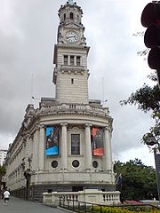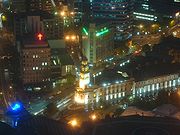
Auckland Town Hall
Encyclopedia
The Auckland Town Hall is a historic building on Queen Street
in downtown Auckland
, New Zealand
, known both for its original and ongoing use for administrative functions (such as Council meetings and hearings), as well as for its famed Great Hall and its separate Concert Chamber. The Town Hall and its surrounding context is highly protected as a 'Category A' heritage place in the city's district plan.

. Costing £ 126,000 to construct, it was designed by Melbourne
architects, JJ & EJ Clarke
, their Italian Renaissance Revival building selected from amongst 46 proposals. The five-storey building was specially designed to fit the wedge-shaped piece of land that had been acquired for it at the meeting of Queen Street and Grey Street. The town hall formed Auckland's first permanent seat of both administration and entertainment in the young city's early history, with its Great Hall (seating 1,673 people) modelled on the Gewandhaus
in Leipzig, and being considered as having one of the finest acoustics in the world.
Its interior was extensively restored from 1994-1997 for NZ$ 33 million, partially because the unreinforced masrony structure did not meet earthquake standards, especially as a gathering place. Sinclair Knight Merz
pioneered various techniques to reinforce the structure without substantially changing the heritage character of the building. The exterior has recently (2007) undergone some restoration work as well.
Original ornate details of the exterior Oamaru limestone had been largely removed in the earthquake hysteria of the 1950s, and during aggressive stone cleaning. These were, after careful research and analysis, replaced during the restoration by new limestone sourced from the same levels of the North Otago quarry that provided the original stone. Interior acoustic performance was corrected through the removal of earlier ill-judged and obtrusive intervention measures, and their replacement by less-visible and more effective treatments. Interior paintwork was restored throughout to the original Edwardian-era colours. Complex fragmented porcelain and glazed ceramic tiling was restored with exact new purpose-made replicas in the lavish main entrance foyer. Stained-glass windows were restored and (where necessary) rebuilt, and the entire building was unobtrusively fire protected.
, also dating from 1911, is the largest musical instrument in the country, and is itself a 'Protected Object' in New Zealand law. It was extensively remodelled in 1969-1970 when the organ reform movement
reached New Zealand, significantly altering and reducing the original Romantic-era power, discarding many parts of the original, and adding new ones to produce a then-fashionable Baroque sound.
The resulting compromised instrument was dismantled in January 2008 for restoration and rebuilding. The rebuilt organ, incorporating remaining parts of the 1911 original, some recently recovered components, and new elements, was built by Orgelbau Klais of Bonn, Germany. It was to return at the end of 2008, to be reassembled as the country's largest (and once again most powerful) organ.
Auckland City had committed itself to providing NZ$3 million to the restoration project, with a $500,000 remainder obtained via private fundraising. The restored organ was officially unveiled on 21 March 2010, with a specially commissioned symphony.
Queen Street, Auckland
Queen Street is the major commercial thoroughfare in the Auckland CBD, Auckland, New Zealand's main population centre. It starts at Queens Wharf on the Auckland waterfront, adjacent to the Britomart Transport Centre and the Downtown Ferry Terminal, and runs uphill for almost three kilometres in a...
in downtown Auckland
Auckland
The Auckland metropolitan area , in the North Island of New Zealand, is the largest and most populous urban area in the country with residents, percent of the country's population. Auckland also has the largest Polynesian population of any city in the world...
, New Zealand
New Zealand
New Zealand is an island country in the south-western Pacific Ocean comprising two main landmasses and numerous smaller islands. The country is situated some east of Australia across the Tasman Sea, and roughly south of the Pacific island nations of New Caledonia, Fiji, and Tonga...
, known both for its original and ongoing use for administrative functions (such as Council meetings and hearings), as well as for its famed Great Hall and its separate Concert Chamber. The Town Hall and its surrounding context is highly protected as a 'Category A' heritage place in the city's district plan.
History

Building
Opened on 14 December 1911 by Lord Islington, then the Governor of New Zealand, the building is one of the most prominent heritage structures on Queen StreetQueen Street, Auckland
Queen Street is the major commercial thoroughfare in the Auckland CBD, Auckland, New Zealand's main population centre. It starts at Queens Wharf on the Auckland waterfront, adjacent to the Britomart Transport Centre and the Downtown Ferry Terminal, and runs uphill for almost three kilometres in a...
. Costing £ 126,000 to construct, it was designed by Melbourne
Melbourne
Melbourne is the capital and most populous city in the state of Victoria, and the second most populous city in Australia. The Melbourne City Centre is the hub of the greater metropolitan area and the Census statistical division—of which "Melbourne" is the common name. As of June 2009, the greater...
architects, JJ & EJ Clarke
John James Clark
John James Clark , an Australian architect, was born in Liverpool, England. Clark’s 30 years in public service, in combination with 33 in private practice, produced some of Australia’s most notable public buildings, as well as at least one prominent building in New Zealand.-Biography:John James...
, their Italian Renaissance Revival building selected from amongst 46 proposals. The five-storey building was specially designed to fit the wedge-shaped piece of land that had been acquired for it at the meeting of Queen Street and Grey Street. The town hall formed Auckland's first permanent seat of both administration and entertainment in the young city's early history, with its Great Hall (seating 1,673 people) modelled on the Gewandhaus
Gewandhaus
Gewandhaus is a concert hall in Leipzig, Germany. Today's hall is the third to bear this name; like the second, it is noted for its fine acoustics. The first Gewandhaus was built in 1781 by architect Johann Carl Friedrich Dauthe. The second opened on 11 December 1884, and was destroyed in the...
in Leipzig, and being considered as having one of the finest acoustics in the world.
Its interior was extensively restored from 1994-1997 for NZ$ 33 million, partially because the unreinforced masrony structure did not meet earthquake standards, especially as a gathering place. Sinclair Knight Merz
Sinclair Knight Merz
Sinclair Knight Merz is an engineering, sciences and project delivery firm. It is based in Australia with offices in Asia, South America, Europe, the Middle East, and New Zealand.-Overview:...
pioneered various techniques to reinforce the structure without substantially changing the heritage character of the building. The exterior has recently (2007) undergone some restoration work as well.
Original ornate details of the exterior Oamaru limestone had been largely removed in the earthquake hysteria of the 1950s, and during aggressive stone cleaning. These were, after careful research and analysis, replaced during the restoration by new limestone sourced from the same levels of the North Otago quarry that provided the original stone. Interior acoustic performance was corrected through the removal of earlier ill-judged and obtrusive intervention measures, and their replacement by less-visible and more effective treatments. Interior paintwork was restored throughout to the original Edwardian-era colours. Complex fragmented porcelain and glazed ceramic tiling was restored with exact new purpose-made replicas in the lavish main entrance foyer. Stained-glass windows were restored and (where necessary) rebuilt, and the entire building was unobtrusively fire protected.
Organ
The Town Hall organPipe organ
The pipe organ is a musical instrument that produces sound by driving pressurized air through pipes selected via a keyboard. Because each organ pipe produces a single pitch, the pipes are provided in sets called ranks, each of which has a common timbre and volume throughout the keyboard compass...
, also dating from 1911, is the largest musical instrument in the country, and is itself a 'Protected Object' in New Zealand law. It was extensively remodelled in 1969-1970 when the organ reform movement
Organ reform movement
The Organ Reform Movement or Orgelbewegung was an early 20th century trend in pipe organ building, originating in Germany and already influential in the United States in the 1940s, waning only in the 1980s...
reached New Zealand, significantly altering and reducing the original Romantic-era power, discarding many parts of the original, and adding new ones to produce a then-fashionable Baroque sound.
The resulting compromised instrument was dismantled in January 2008 for restoration and rebuilding. The rebuilt organ, incorporating remaining parts of the 1911 original, some recently recovered components, and new elements, was built by Orgelbau Klais of Bonn, Germany. It was to return at the end of 2008, to be reassembled as the country's largest (and once again most powerful) organ.
Auckland City had committed itself to providing NZ$3 million to the restoration project, with a $500,000 remainder obtained via private fundraising. The restored organ was officially unveiled on 21 March 2010, with a specially commissioned symphony.
External links
- Auckland Town Hall (official website)

